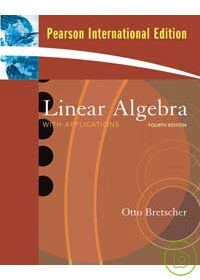- 定價127.00元
-
8
折優惠:HK$101.6

|
|
|
|
LINEAR ALGEBRA WITH APPLICATIONS 4/E (S-PIE)
|

|

沒有庫存
訂購需時10-14天
|
|
|
|

|
|
9780135128664 | |
|

|
|
BRETSCHER | |
|

|
|
全華科技 | |
|

|
|
2009年1月01日
| |
|

|
|
383.00 元
| |
|

|
|
HK$ 363.85
|
|
|
|
|

| |
|
|
|
|
| |
|
|
詳
細
資
料
|
* 叢書系列:大專一般
* 規格:平裝 / 504頁 / 普級 / 單色印刷 / 初版
* 出版地:台灣
大專一般
|
|
分
類
|
專業/教科書/政府出版品 > 數理化類 > 數學 |
同
類
書
推
薦
|
|
|
內
容
簡
介
|
Offering the most geometric presentation available, Linear Algebra with Applications, Fourth Edition emphasizes linear transformations as a unifying theme. This elegant textbook combines a user-friendly presentation with straightforward, lucid language to clarify and organize the many techniques and applications of linear algebra. Exercises and examples make up the heart of the text, with abstract exposition kept to a minimum. Extensive problem sets keep students involved in the material, while genuine applications for a broad range of sciences prepares them for the methods and models of contemporary scientists. In addition, the wealth and variety of exercise sets enable instructors to design a course to best suit the goals and needs of their students. This revision reflects careful review and appropriate changes to the wording of each idea, while preserving the content structure of the previous edition.
本書特色
NEW - Many new exercises of all difficulty levels have been added, from the elementary to the challenging. For example, there are twenty-four new exercises on conic and cubic curve fitting that lead up to a discussion of the Cramer-Euler Paradox on fitting a cubic through nine points. NEW - The section on matrix products now follows discussion of the inverse of a matrix, making the presentation more sensible from an algebraic point of view. The determinant is defined in terms of patterns, a transparent way to deal with permutations; Laplace expansion and Gaussian elimination are presented as alternative approaches. This presentation strikes a balance between earlier editions of this text. NEW - Hundreds of improvements include hints on especially difficult problems and revised notations and explanations on many theorems.
1 . Linear transformations are introduced early in the text to make the discussion of matrix operations more meaningful and easier to navigate.
2 . Visualization and geometrical interpretation are emphasized extensively throughout the text.
3 . An abundance of problems, exercises, and applications help students assess their understanding and master the material.
4 . Abstract concepts are introduced gradually throughout the text. Major ideas are carefully developed at various levels of generality before the student is introduced to abstract vector spaces.
5 . Discrete and continuous dynamical systems are used as a motivation for eigenvectors and as a unifying theme thereafter.
6 . Fifty to sixty True/False questions conclude every chapter, testing conceptual understanding and encouraging students to read the text.
7 . Historical problems from ancient Chinese, Indian, Arabic, and early European sources add diversity to the selection of exercises.
8 . Rotations, reflections, projections, and shears are used throughout to illustrate new ideas.
9 . Multiple perspectives on the kernel of a matrix are presented, with a stronger emphasis on the relations among the columns.
10 . Commutative diagrams enhance students’’ conceptual understanding of the matrix of a linear transformation. These diagrams enable students to visualize the relations between linear transformations.
11 . A more conceptual approach to the QR factorization is presented, in terms of a change-of-basis.
12 . The determinant is introduced in terms of Laplace expansion rather than permutations, with Gaussian elimination and permutations still presented as alternative methods.
|
|
目
錄
|
1. Linear Equations
1.1 Introduction to Linear Systems
1.2 Matrices, Vectors, and Gauss-Jordan Elimination
1.3 On the Solutions of Linear Systems; Matrix Algebra
2. Linear Transformations
2.1 Introduction to Linear Transformations and Their Inverses
2.2 Linear Transformations in Geometry
2.3 Matrix Products
2.4 The Inverse of a Linear Transformation
3. Subspaces of R” and Their Dimensions
3.1 Image and Kernel of a Linear Transformation
3.2 Subspace of R”; Bases and Linear Independence
3.3 The Dimension of a Subspace of R”
3.4 Coordinates
4. Linear Spaces
4.1 Introduction to Linear Spaces
4.2 Linear Transformations and Isomorphisms
4.3 The Matrix of a Linear Transformation
5. Orthogonality and Least Squares
5.1 Orthogonal Projections and Orthonormal Bases
5.2 Gram-Schmidt Process and QR Factorization
5.3 Orthogonal Transformations and Orthogonal Matrices
5.4 Least Squares and Data Fitting
5.5 Inner Product Spaces
6. Determinants
6.1 Introduction to Determinants
6.2 Properties of the Determinant
6.3 Geometrical Interpretations of the Determinant; Cramer’s Rule
7. Eigenvalues and Eigenvectors
7.1 Dynamical Systems and Eigenvectors: An Introductory Example
7.2 Finding the Eigenvalues of a Matrix
7.3 Finding the Eigenvectors of a Matrix
7.4 Diagonalization
7.5 Complex Eigenvalues
7.6 Stability
8. Symmetric Matrices and Quadratic Forms
8.1 Symmetric Matrices
8.2 Quadratic Forms
8.3 Singular Values
9. Linear Differential Equations
9.1 An Introduction to Continuous Dynamical Systems
9.2 The Complex Case: Euler’s Formula
9.3 Linear Differential Operators and Linear Differential Equations
Appendix A. Vectors
Answers to Odd-numbered Exercises
Subject Index
Name Index
|
|
|
書
評
|
|
|
|
|

